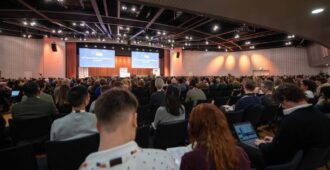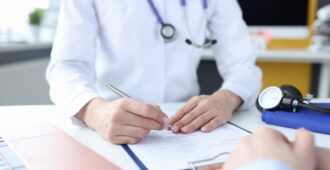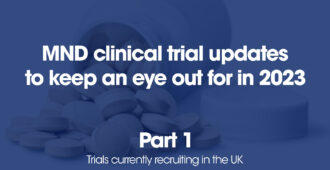Our recent blog articles describe lots of fascinating science and the progress in the care and treatment of MND/ALS that was presented at the symposium. Personally, another really positive aspect was the opportunity to meet some of the researchers face-to-face. This included several senior scientists and clinicians whose work we support, some of whom gave lectures or chaired sessions. The symposium also gave presentation opportunities to PhD students and post-doctoral scientists, some of whom were attending their first International Symposium. We invited several from the UK to an ‘ice-breaker’ social on the Friday evening before the main lecture sessions began. Not all were able to attend, but a good group gathered with us, getting to know each other, and we met others later as they presented their posters.
Sheffield University was well represented, including current grantees Emily Goodall and Clare Wood-Allum who both presented posters. Newer to ALS research was Guiseppe (‘Bepe’) Battaglia part of a cross-disciplinary group of collaborators who call themselves ViNCeNS for ‘Virus-like Nanoparticles for targeting the Central Nervous System’ with a website at www.vincens.group.shef.ac.uk/index.htm.
‘Fishing’ for new animal models of MND
Two others at our ‘ice-breaker’ gave lectures during the Saturday session on ‘Emerging Disease Models’. Marc Da Costa (also from Sheffield) described some outcomes of his PhD project developing a new zebrafish with a mutated SOD1 gene. Zebrafish are popular models for neurological conditions (there was a second presentation from an US-based group), as the fish embryos are transparent, so their neurones can be studied easily under the microscope. Their muscular strength can be judged by the amount they move (studied by automated analysis of video) or by their progress swimming against a ‘current’ in a tube. Marc studies the differences between fish with normal or mutant SOD1. The latter have more difficulty swimming, and are more vulnerable to stress (for example, added toxic chemicals). Marc can test the effects of potential drugs on the stressed fish, and has already seen some promising results.
Looking in a ‘library’ for MND mice
Another new animal model was presented by Peter Joyce (MND Association funded, based at the Medical Research Council Laboratories near Oxford). His mouse strain carries a mutation (mistake) in its native (mouse) SOD1 gene, matching one recently reported from a human family with ALS. This is different from the more established SOD1 mouse model, in which the MND-like symptoms develop as a result of multiple copies of an added human mutant gene. Peter is studying the timescale in which muscle problems develop, relating these to changes in the neurones. The MRC has a huge ‘library’ of mouse mutations available, so Peter will be investigating if others match mutations reported in different ALS families, possibly looking for collaborators to work on these.
Presenting the impact of healthcare decisions
A completely different type of research was presented as posters by two researchers working with Carolyn Young at the University of Liverpool. Hikari Ando has been studying the reasons why some people with MND decide not to accept the offer of non-invasive ventilation (NIV), and the extent to it is actually used by at home. Chris Gibbons’ work covered the assessment of quality of life for people with MND, particularly the role of fatigue and depression.
Final thoughts
It was particularly inspiring to meet so many UK-based researchers, filling all of us from the MND Association with more incurable optimism. Of course we also met many other people too – the attendees, many of whom collaborate internationally, came from more than 30 countries.





